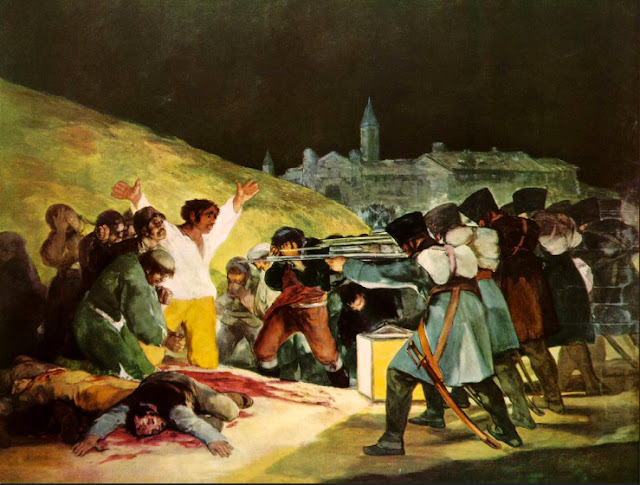Intermission, part 6
The narrative began with Act 1, scene 1 on April 10, 2013.
To access all scenes, scroll to blog archive at the bottom of the page.
This intermission attempts to track the connected artistic 'lineage' of some influential painters, from the early 15th century to the present. To follow this thread and to see all images mentioned,
go back to part 1 of this intermission.
This intermission attempts to track the connected artistic 'lineage' of some influential painters, from the early 15th century to the present. To follow this thread and to see all images mentioned,
go back to part 1 of this intermission.
The crushing realities of the Napoleonic wars also profoundly affected Goya. Although one would not consider his painting The Third of May romantic in any way, it is almost electrically charged with emotion, a key ingredient in the art of the Romantic period. Goya composes a tableau that sets in opposition the conflicting human responses to the chaotic conditions of the time – the desire for a logical solution to all problems (the orderly efficiency of the firing squad), and the real emotional response to oppression and tragedy (the victims).
Francisco Goya, The Third of May 1808, 1814
The testy relationship between these two human characteristics (logic and emotion) has provided fertile ground for exploration by many artists (including the author) through to the present day. And this interest is not limited to the traditional arts. Some of the characters in the cultish sic-fi TV show Star Trek, for example were developed in order to explore this precise dynamic. Think of Spock and McCoy, or in The Second Generation series, Data and Giordi. It's a theme I think you'll often find in theatre, TV, movies dance and opera.
In his later years, Goya's work entered the realm of psychology, something we tend to think of as a 20th century preoccupation.
Francisco de Goya, Bobalicón, 1816-1823

